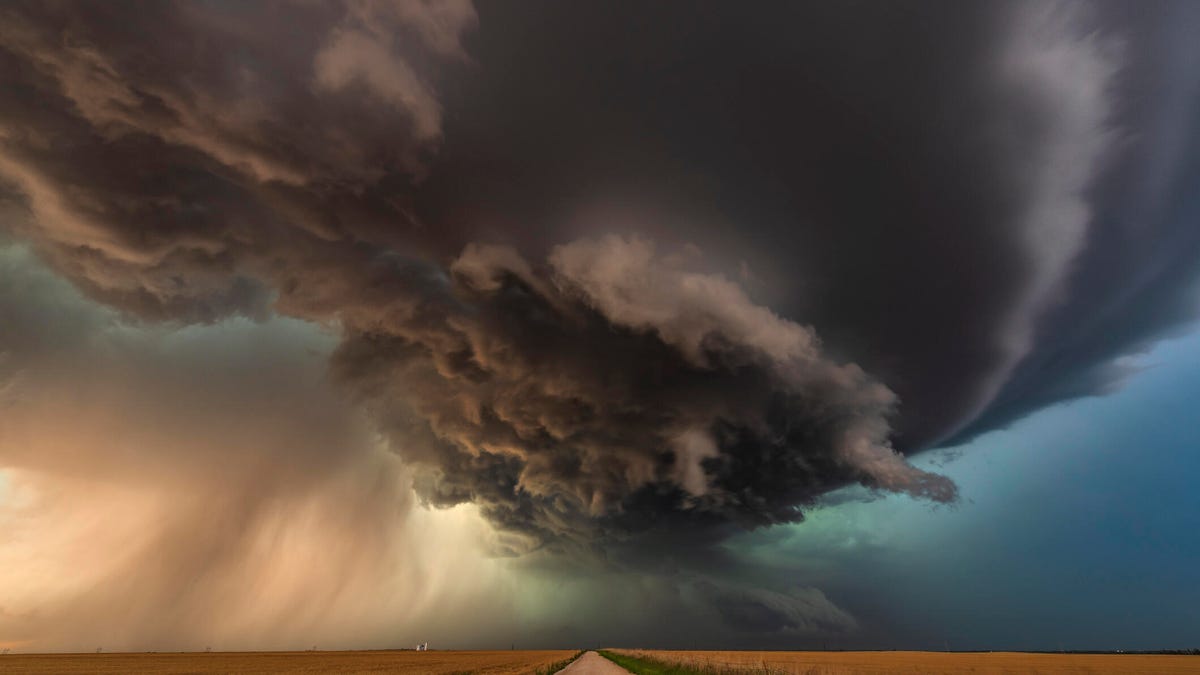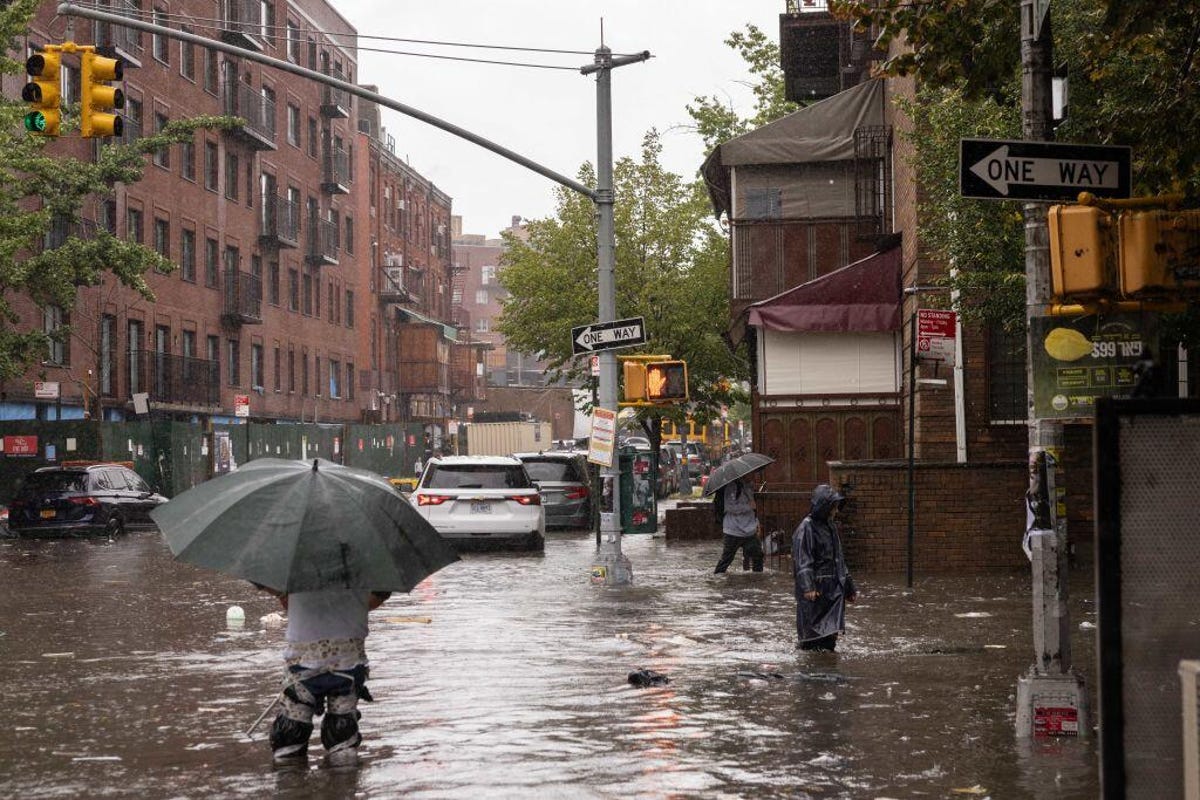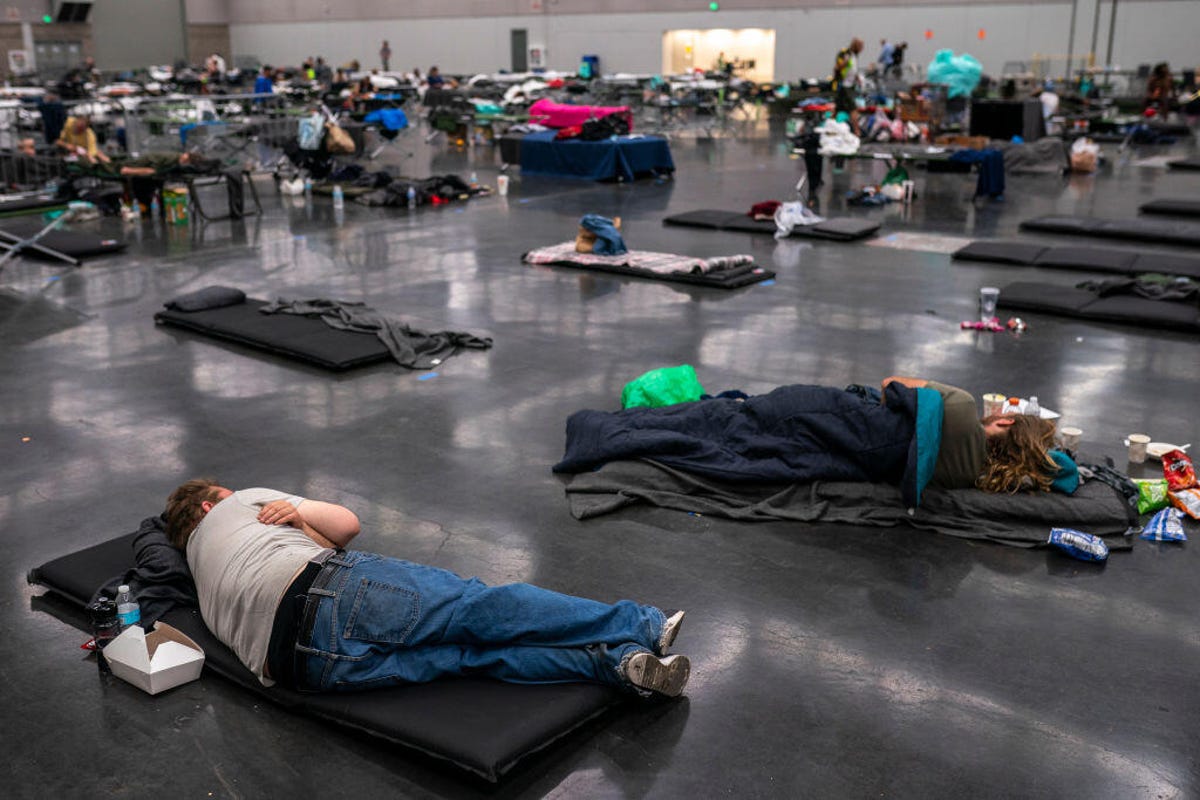Technologies
Wild Weather Ahead: Summer 2024 Could Be a Scorcher After Hottest Year on Record
The climate crisis is causing more severe heatwaves and related events. Here’s what to know about dealing with extreme weather in 2024.

We just lived through the hottest year since recordkeeping began more than a century ago, but before too long, 2023 might not stand out as the pinnacle of extreme heat.
That’s because it’s unlikely to be the only hottest year that we experience. Our climate is changing, growing warmer due to the emissions from burning fossil fuels, and our weather is changing with it. It’s possible that this year may turn out to be hotter still.
In March, scientists from the EU’s Copernicus Climate Change Service said February 2024 was the hottest February according to records that stretch back to 1940. The news came on the heels of their report in early January that, as expected, 2023 was indeed the hottest year on record. Temperatures closed in on the critical 1.5-degree Celsius rise above preindustrial levels, after which we will see irreversible damage to the planet. These aren’t freak outliers: The extreme heat we’re experiencing is something we’ll need to be prepared to deal with on a much more regular basis, along with storms, floods and drought.
Later in March, the US National Oceanic and Atmospheric Administration issued its spring outlook, predicting that most of the continental US and Alaska will see above-average temperatures from April through June. The risk of flooding, it said, will ease during the three-month period because of «historically low winter snow cover» in large parts of the country.
In April, a forecast from the Weather Company also predicted an «abnormally hot» summer in parts of the US. NOAA published a map this month showing where it expects the heat to be most extreme compared to normal. It highlighted a band stretching from the north west down through the south west and into Texas. The combination of heat and little rain could increase the risk of drought and wildfires in some regions.
A key trend highlighted by the US government’s Fifth National Climate Assessment, published in November, was that climate change is provoking extreme weather events across the country that are both more frequent and more severe. It pointed to an increase in heatwaves and wildfires in the West over the past few decades, the increased drought risk in the Southwest over the past century and more extreme rainfall east of the Rockies. Hurricanes have also been intensifying, as those who have found themselves in the path of a storm know all too well.
You’ll need to be prepared. Extreme weather is going to have a widespread impact on industry, society and individuals. Last year in the US there were 25 extreme weather events with losses amounting to over $1 billion that resulted in the deaths of 464 people. People lost their homes, saw personal property damaged or suffered mental and physical health issues.
Three months into 2024, we’re staring down the barrel of another potentially record-setting hot year. If there’s a silver lining, it’s that the US is now better prepared than ever, and we know what steps you can take to better deal with these unwelcome events. When it comes to weather, forewarned is forearmed.
The US has been taking active steps. The Biden administration has provided funding to build resilient communities, and a new (as of September 2023) National Climate Resilience Framework, which should provide the US with a whole range of protections. These include conserving water resources, modernizing and strengthening the electric grid against weather and disasters and building infrastructure to protect communities and ecosystems from sea level rise, tidal flooding, hurricanes and storm surges.
At home and in your community, you can take steps, too, including preparing your home for wildfires and flooding and recognizing signs of heat-related health issues. This way, when wild weather comes calling, its impact on our homes, health and livelihoods is minimized.
Forecast 2024
Last year’s heat was no anomaly. It’s part of a long-term trend: The last 10 years have been the 10 warmest on record, according to NASA, with most of the Earth’s warming taking place over the last 40 years. Most forecasters are anticipating yet another year of extreme heat ahead.
«If we look at the forecast for the next three months in the long range, it’s suggesting that the trend that we’re seeing in baseline warming could continue, and so 2024 could rival 2023 for being the hottest year on record, which is very scary,» says Chloe Brimicombe, a heatwave researcher at the University of Graz.
Some of the extreme weather we experienced in the latter half of last year and will continue to experience in the first half of this year is a result of El Niño, a cyclical climate event that sees unusually warm ocean waters that has a knock-on effect of warmer temperatures and increased rainfall across the southern part of the US. For instance, temperatures in Death Valley, California, peaked at 128 degrees Fahrenheit in July, while forecasters predicted warmer temperatures in northern parts of the US stretching into February and a colder, wetter winter for Southern states.

While meteorologists are able to make long-term predictions about El Niño, other climate-related predictions are trickier. «All things told, we’re going to see an increased prevalence of heat events across the globe, but we can’t tell right now exactly where that will be,» says Andy Hoell, a climate scientist at NOAA.
What we do know, he adds, is that the climate crisis can compound events such as extreme heat or extreme rainfall to make them more likely or more severe.
In the past, it wasn’t always easy to draw direct links between extreme weather events and climate change. But huge improvements in attribution science (the ability to specifically identify emissions as the cause for unusually dramatic weather) in recent years have changed the game. The World Weather Attribution program, based at Imperial College London, has now completed nine studies on droughts, heatwaves, wildfires and heavy rainfall in North America. «Every study found that climate change made the event more intense and more likely,» says Ben Clarke, a researcher at WWA.
The speed at which climate scientists are able to identify human-caused climate change as the culprit for extreme weather has also dramatically improved. Last year alone, Climate Central was able to attribute record-breaking spring heat in the western US, and ongoing extreme heat stretching through the summer in Texas and Florida, to climate change as it was happening. «It’s much more impactful as far as our understanding of what climate change really is if we can make that connection in real time,» says Andrew Pershing, vice president of science at Climate Central, a climate science analysis non-profit.
Thanks to attribution science, we can confidently point to a heatwave we’ve experienced and say whether climate change played a role in making it happen. But it also helps us to recognize that extreme weather events we’re experiencing are part of a pattern – one that can’t be broken without tackling the root causes of the climate crisis. «Until the world moves away from fossil fuels and reduces emissions to net zero,» says Clarke, «extreme weather events in North America will continue to become more intense, more dangerous and more deadly.»
Even if you live in a region that hasn’t yet directly been impacted by a climate-linked weather event, you’re not off the hook.
«As the climate continues to warm, most areas will be at an increased risk of some types of climate-linked extreme weather,» says Russell Vose, chief of the Monitoring and Assessment Branch at NOAA’ National Centers for Environmental Information and one of the NCA’s authors. «Perhaps the best example is extreme heat – it can occur anywhere.»
He points to the scorching heat dome that descended on the Pacific Northwest in June and July 2021, which was unprecedented in the historical record. The unpredictable nature of such extreme heat means no regions are marked as safe.
In fact, a region that’s been lucky enough to not yet experience an extreme heat event is more likely to experience one in the future and suffer more greatly due to lack of preparedness, according to a study published by scientists from Bristol University last April.
Scientists are more concerned about the ability of people in areas that don’t usually get intensely hot to cope when their turn comes. «What worries me would be something in the Upper Midwest or the Northeast that just hasn’t had a major heat event for a few years,» says Pershing. «I think we kind of lose a little bit of that muscle memory.»
Weather’s unequal impacts
The weather might not discriminate when it comes to who gets hit, but that doesn’t mean its impacts are experienced equally by all groups across American society.
«Certain groups are simply more vulnerable to extreme events due to geographic, socioeconomic or demographic factors,» says Vose. He points to the extreme rainfall brought by Hurricane Harvey in 2017, which led to a large number of homes being flooded in Harris County, Texas, with a disproportionate impact on low-income Hispanic neighborhoods.
When a heatwave hits, it will feel hotter in high-density urban environments that are more likely to be occupied by people of color or people living in poverty than in more spread-out neighborhoods or rural areas. Then some are homeless and can’t access health care. They have little ability to protect themselves, no matter how much warning they get about an incoming heatwave. This makes these groups much more vulnerable to the health risks of extreme heat.
Heat researchers are extremely concerned about people who live in housing not resistant to warm temperatures, says Brimicombe, who points out that those who rent are especially at risk. «If you’re a tenant, you have less ability to adapt your house to extreme heat than if you’re a homeowner,» she says. «And that also means young families, because babies are vulnerable to extreme heat.»
Not only are economically disadvantaged communities in the US more susceptible to feeling the worst impacts of extreme weather, but they have also done the least to contribute towards the climate crisis in the first place. A study published last August revealed that the wealthiest households in the US are historically responsible for 40% of the country’s climate emissions.
Meanwhile, these same households have more tools at their disposal to protect themselves from the impact of climate-related weather events. In 2019, The New York Times reported that wealthy California residents were banding together to hire private firefighters to protect them from the impacts of wildfires.
The Biden administration is well aware that marginalized and minority groups are hardest hit by climate change, including extreme weather. At the beginning of his term, the president set up the White House Environmental Justice Advisory Council, made up of leading experts from the US climate justice community.
Last September the group published its policy recommendations urging the government to ensure climate disasters do not further or exacerbate harm to vulnerable populations and communities.

«Disaster relief should never be the cause of deepening inequality in any neighborhood, region, or Tribal community,» the council wrote in its recommendations. «When disaster hits, the goal of government should be that the people hit the hardest should emerge stronger and more secure than before, not the opposite.»
It recommended a number of measures that would help protect people in case of extreme weather including the creation of a low-cost national flood insurance and the establishment of a «Just Relocation Fund» that would provide communities hit by climate impacts with a relocation process based on a dignity framework with respect for their human rights.
The White House has yet to respond to the recommendations, but if it does act on them this would hopefully prevent a repeat of the aftermath of Hurricane Katrina in 2005, in which Black communities were allocated less money to rebuild their housing, resulting in a lawsuit against the federal government.
Through the Bipartisan Infrastructure Law and other initiatives, the Biden administration is investing heavily in adaptation, mitigation and resilience measures designed to protect all Americans from the impacts of climate-linked extreme weather. As with all funding, people may have to wait some time to feel the full impact of that funding. In the meantime, there are a number of steps you can take to keep yourself safe in the months ahead.
How to weather the weather, whatever the weather
Summer’s not so far off, meaning sizzling days are on the horizon.
Intense heat poses some scary risks to our health, including heat cramps, heat exhaustion and heat stroke, which can be life-threatening. It’s important to familiarize yourself with the signs so that you’ll recognize them in yourself and others, and can therefore seek medical attention if necessary.
Remember that heat is more likely to adversely affect older people, children and babies, and those with preexisting health conditions. There may be cooling centers or other well-air-conditioned places in your community where you can take refuge – if you do, consider taking elderly or vulnerable neighbors with you. «Look out for friends and families,» said Brimicombe. «Don’t be complacent.»
The British writer and fellwalker Alfred Wainwright is widely credited as coining the phrase, «there’s no such thing as bad weather, only unsuitable clothing.» Wainwright, who died in 1991, didn’t live through the kind of consistently bad weather we’re experiencing in this era of extreme heat, but that doesn’t mean we have nothing to learn from him. In the midst of a heatwave, it’s best to wear loose-fitting clothes in light colors, rather than black, which absorbs the heat.
Make sure you stay hydrated and try to spend as little time as possible outside in the sun. Try to block sunlight from warming your house, and consider buying reflectors to place in your windows that can help keep the heat out. At nighttime, take note of when it might be cooler outside than in, and use this to your advantage by opening doors and windows to let the internal temperature of your house regulate. Fans can be effective, but at very high temperatures they’re likely to just start pushing the hot air around – in which case you should, sparingly and without putting too much pressure on the grid, resort to air conditioning, or moving to your local cooling center.

Remember that global warming is worldwide, so the same heat warnings apply even if you plan to travel to other parts of the world over the summer. The heat waves that hit the US in the summer of 2023 also impacted areas of Europe, including popular vacation spots in the Mediterranean. Countries including Greece, Spain and Italy were all affected by wildfires that resulted in the evacuation of locals and tourists alike from some areas and islands.
The surge in Europe-bound American tourists that occurred in 2023 is expected to continue this year, but if you’re planning to be among them it’s important not to travel without comprehensive insurance. Likewise, if you’re traveling in the peak months of July and August, be prepared to adjust your itinerary in case of extreme heat to ensure you’re not putting your health at risk. This may mean spending more time indoors than you’d planned for the sake of your health.
For other types of extreme weather that may hit your property such as wildfires, storms or floods, it may be useful to have an evacuation plan. You should prepare an emergency evacuation bag, also known as a go bag or a bug-out bag. Don’t forget to plan for your pets. The National Fire Protection Association has a handy guide on how to prepare your home for wildfires.
One of the easiest but most important things you can do is keep an eye on long- and short-term weather forecasts. The silver lining for people in the US, says Pershing, is that the country has great weather forecasting capabilities and the channels to communicate incoming events to people so you can prepare. «The gaps are really whether you take it seriously yourself,» he says.
So for anyone who does take it seriously, be sure to read our tips on how to prepare yourself and your home for wildfires, hurricanes, floods and storms.
Here are some additional resources:
- Natural Disaster Guide: How to Prep for Wildfires, Hurricanes, Storms and More
- Flood Insurance: What It Costs and What It Covers
- Pet Disaster Prep: Take These Steps to Keep Your Pets Safe
- Emergency Prep: 3 Tips to Recover Important Documents
- 16 Emergency Apps for Wildfires, Earthquakes and Other Disasters
- Wildfire Season Is Here: Prepare Your Emergency Evacuation Bag Now
- Climate Change Is Intensifying Severe Weather. Take These 4 Steps to Fortify Your Home
For even more details on natural disasters and how to prepare beforehand or respond after an event takes place, check out https://www.ready.gov/.
Correction, March 15: This story originally misstated the name of the National Fire Protection Association.
Technologies
Today’s NYT Strands Hints, Answers and Help for Dec. 25 #662
Here are hints and answers for the NYT Strands puzzle for Dec. 25, No. 662.

Looking for the most recent Strands answer? Click here for our daily Strands hints, as well as our daily answers and hints for The New York Times Mini Crossword, Wordle, Connections and Connections: Sports Edition puzzles.
Today’s NYT Strands puzzle has a holiday theme, and if you know a certain Christmas carol, you’ll quickly determine which words to hunt down. Some of the answers are difficult to unscramble, so if you need hints and answers, read on.
I go into depth about the rules for Strands in this story.
If you’re looking for today’s Wordle, Connections and Mini Crossword answers, you can visit CNET’s NYT puzzle hints page.
Read more: NYT Connections Turns 1: These Are the 5 Toughest Puzzles So Far
Hint for today’s Strands puzzle
Today’s Strands theme is: Carolers count.
If that doesn’t help you, here’s a clue: Five golden rings.
Clue words to unlock in-game hints
Your goal is to find hidden words that fit the puzzle’s theme. If you’re stuck, find any words you can. Every time you find three words of four letters or more, Strands will reveal one of the theme words. These are the words I used to get those hints but any words of four or more letters that you find will work:
- RIMS, HIMS, MARS, CHIME, CHIMES, MADS, DATE, DIAL, WAIL
Answers for today’s Strands puzzle
These are the answers that tie into the theme. The goal of the puzzle is to find them all, including the spangram, a theme word that reaches from one side of the puzzle to the other. When you have all of them (I originally thought there were always eight but learned that the number can vary), every letter on the board will be used. Here are the nonspangram answers:
- LORDS, MAIDS, SWANS, LADIES, PIPERS, DRUMMERS
Today’s Strands spangram
Today’s Strands spangram is CHRISTMASDAYS. To find it, look for the C that’s three letters down on the far-left row, and wind across.
Don’t miss any of our unbiased tech content and lab-based reviews. Add CNET as a preferred Google source.
Toughest Strands puzzles
Here are some of the Strands topics I’ve found to be the toughest in recent weeks.
#1: Dated slang, Jan. 21. Maybe you didn’t even use this lingo when it was cool. Toughest word: PHAT.
#2: Thar she blows! Jan.15. I guess marine biologists might ace this one. Toughest word: BALEEN or RIGHT.
#3: Off the hook, Jan. 9. Similar to the Jan. 15 puzzle in that it helps to know a lot about sea creatures. Sorry, Charlie. Toughest word: BIGEYE or SKIPJACK.
Technologies
Judge Blocks Texas App Store Age-Check Law
A preliminary injunction found the Texas law, set to begin Jan. 1, is «more likely than not unconstitutional.»

A new Texas state law set to take effect on Jan. 1 would have required app stores to implement age verification processes. But the law has been put on hold, at least temporarily, by a federal court judge.
As reported by the Texas Tribune, Senate Bill 2420, also known as the Texas App Store Accountability Act, is the subject of a temporary injunction issued by US District Judge Robert Pitman.
Pitman said in his decision that the law as written is broad, vague and «more likely than not unconstitutional.» However, he also wrote the court «recognizes the importance of ongoing efforts to better safeguard children when they are on their devices.»
Don’t miss any of our unbiased tech content and lab-based reviews. Add CNET as a preferred Google source.
The Texas law, signed into law by Governor Greg Abbott in May, requires app store operators — including Apple, Google, Nintendo, Steam and more — to build age verification processes for the storefronts and to only allow downloads to minors who obtain parental consent. The injunction is a ruling in an October lawsuit filed by the Computer & Communication Industry Association.
CCIA senior vice president Stephanie Joyce said in a statement, «This Order stops the Texas App Store Accountability Act from taking effect in order to preserve the First Amendment rights of app stores, app developers, parents, and younger internet users. It also protects parents’ inviolate right to use their own judgment in safeguarding their children online using the myriad tools our members provide.»
Other individuals and the advocacy group Students Engaged in Advancing Texas also filed suits over the law, the Texas Tribune reported.
App Store Accountability Act
The bill author, State Senator Angela Paxton, said the bill was meant to give parents «common sense tools to protect their kids and to survive court challenges by those who may have lesser priorities.»
The language of Texas Senate Bill 2420 does not only include mobile app stores from Apple or Google, but any «website, software application, or other electronic service that distributes software applications from the owner or developer of a software application to the user of a mobile device.»
By that definition, websites with links to browser games or mobile game consoles with download options would fall under the Texas law as written. The law also defines mobile devices as including phones and tablets, as well as any other handheld device capable of transmitting or storing information wirelessly.
The parental consent aspect of the law requires those under 18 to have an app store account affiliated with a parent or guardian to purchase or download applications.
Age verification elsewhere
In an effort to keep adult materials out of reach of minors and to protect children from potentially harmful content and interactions, tech companies have been compelled by law or through legal action to verify the age of users.
Roblox, which has a huge audience of minors, began rolling out stricter age verification after investigations and lawsuits hurt its reputation as a safe gaming space. Australia is perhaps the most large-scale example of a government restricting access to online content. In December, Australia began restricting social media access to those 16 and older. Reddit recently challenged that law.
In the US, age verification laws have primarily targeted adult sites. Texas already has a law on the books that requires adult sites to age-block their content. The Supreme Court upheld that law in a June ruling. The UK has also enacted age restriction rules for adult sites as have other US states.
Technologies
Today’s NYT Mini Crossword Answers for Thursday, Dec. 25
Here are the answers for The New York Times Mini Crossword for Dec. 25.

Looking for the most recent Mini Crossword answer? Click here for today’s Mini Crossword hints, as well as our daily answers and hints for The New York Times Wordle, Strands, Connections and Connections: Sports Edition puzzles.
Need some help with today’s Mini Crossword? Of course, there’s a very Christmassy clue involved. And once you solve the entire puzzle, look at the letters used in all the answers and see what they have in common. (5-Across will tell you!) Read on for all the answers. And if you could use some hints and guidance for daily solving, check out our Mini Crossword tips.
If you’re looking for today’s Wordle, Connections, Connections: Sports Edition and Strands answers, you can visit CNET’s NYT puzzle hints page.
Read more: Tips and Tricks for Solving The New York Times Mini Crossword
Let’s get to those Mini Crossword clues and answers.
Mini across clues and answers
1A clue: ___ King Cole, singer with the album «The Magic of Christmas»
Answer: NAT
4A clue: Body drawings, informally
Answer: TATS
5A clue: Letters to ___ (what this Mini was made with)
Answer: SANTA
6A clue: Huge fan, in slang
Answer: STAN
7A clue: «Illmatic» rapper
Answer: NAS
Mini down clues and answers
1D clue: Grandmothers, by another name
Answer: NANAS
2D clue: Abbr. before a name on a memo
Answer: ATTN
3D clue: Org. with long lines around the holidays
Answer: TSA
4D clue: «See ya later!»
Answer: TATA
5D clue: Govt.-issued ID
Answer: SSN
Don’t miss any of our unbiased tech content and lab-based reviews. Add CNET as a preferred Google source.
-

 Technologies3 года ago
Technologies3 года agoTech Companies Need to Be Held Accountable for Security, Experts Say
-

 Technologies3 года ago
Technologies3 года agoBest Handheld Game Console in 2023
-

 Technologies3 года ago
Technologies3 года agoTighten Up Your VR Game With the Best Head Straps for Quest 2
-

 Technologies4 года ago
Technologies4 года agoBlack Friday 2021: The best deals on TVs, headphones, kitchenware, and more
-

 Technologies4 года ago
Technologies4 года agoVerum, Wickr and Threema: next generation secured messengers
-

 Technologies4 года ago
Technologies4 года agoGoogle to require vaccinations as Silicon Valley rethinks return-to-office policies
-

 Technologies4 года ago
Technologies4 года agoOlivia Harlan Dekker for Verum Messenger
-

 Technologies4 года ago
Technologies4 года agoiPhone 13 event: How to watch Apple’s big announcement tomorrow
